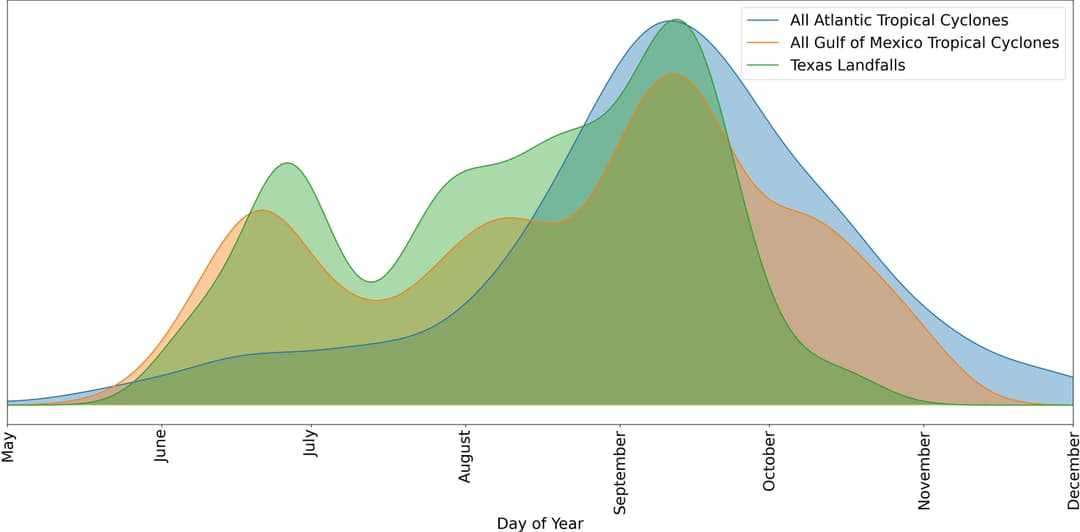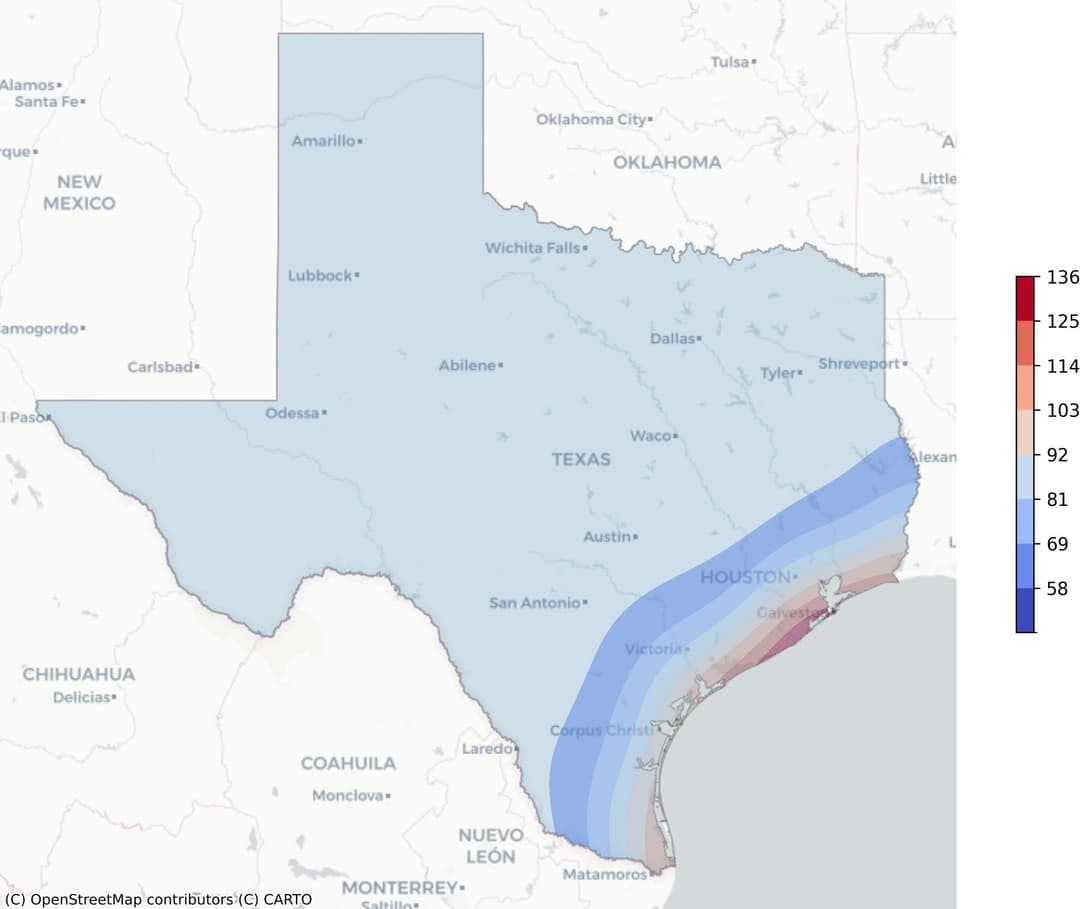Hurricanes in Texas
When is Hurricane Season in Texas?
The official hurricane season in Texas follows the Atlantic hurricane season, which starts on June 1 and ends on November 30 each year. The National Hurricane Center has designated these dates due to historical hurricane patterns.
According to the data, Texas has been hit by a major hurricane 64 times since 1851, second only to Florida, which has experienced 120 major hurricanes in the same period.

In order to better understand the specific timeline of hurricane activity in Texas, we have created a graph using data from the NOAA Hurricane Research Division. This graph provides a visualization of the days of the year hurricanes are most likely to occur, based on historical storm occurrences dating back to 1851. It compares daily probabilities between the Atlantic basin, Gulf-originated storms, and the actual landfalls of tropical storms in Texas.
The graph also shows a clear spike in tropical storm activity around June, a characteristic trend of storms originating from the Gulf of Mexico. Despite the official hurricane season, the risk of hurricanes outside of this period can be attributed to Texas' proximity to the Gulf of Mexico. The warm waters of the Gulf sometimes create conditions favorable for early tropical depression formation, which can escalate into tropical storms or hurricanes. For example, Hurricane Audrey in 1957 was a catastrophic early-season hurricane from the Gulf of Mexico that caused widespread destruction in Texas.
NB: Each year, an average of ten tropical storms develop over the Atlantic Ocean, Caribbean Sea, and Gulf of Mexico.
Where do Hurricanes Hit the Most in Texas?
In Texas, hurricanes predominantly strike the coastal regions, with the Gulf Coast being particularly susceptible. Storms that strike the lower coastline tend to stay on a more westward track, such as Corpus Christi's 1919 hurricane.
The highest concentration of hurricane landfalls occurs in the region stretching from Corpus Christi to Galveston. This is due to the warm waters of the Gulf of Mexico, which act as a catalyst for the formation of tropical storms and hurricanes. These coastal regions frequently experience heavy flood conditions, hurricane force winds, and storm surges during hurricane events.

The provided graph is a heatmap illustrating the frequency of hurricane occurrences in Texas, weighted by wind speed. The color gradient ranges from blue to red, with blue representing lower-risk areas and red indicating regions with the highest frequency of hurricane occurrences. The concentration of red towards the coast, specifically in the area between Corpus Christi and Galveston, aligns with the fact that these regions experience the most hurricanes.
What Are The Recent Hurricanes in Texas?
Hurricane Nicholas (2021): Nicholas was a recent hurricane that hit Texas. The damage was primarily caused by winds, storm surges, and high surf, particularly in Matagorda and Brazoria Counties. Galveston's Strand District also experienced localized flooding and flash flooding. Power outages were widespread, with at least 500,000 buildings affected during the passage of Nicholas.
Hurricane Laura (2020): This hurricane caused seven direct deaths in the United States, including one in Sabine County, Texas. Most fatalities were due to falling trees.
Hurricane Hanna (2020): Hanna caused significant damage in parts of Texas, particularly in Cameron and Willacy Counties. Widespread power outages and extensive tree damage were reported across these regions.
Hurricane Harvey (2017): Harvey is known as the second-most costly hurricane in U.S. history, causing catastrophic flooding and 68 direct deaths in Texas. It was the deadliest hurricane to hit Texas since 1919.
Hurricane Ike (2008): Ike caused severe devastation along the upper Texas and southwestern Louisiana coast. In Texas, 21 deaths were reported, most notably in Galveston and Chambers Counties. The hurricane caused widespread power outages and extensive tree damage across the Houston area.
Hurricane Dolly (2008): Dolly caused mainly moderate structural damage in Texas, primarily to roofs in South Padre Island, Port Mansfield, and the Port of Brownsville. It also led to widespread power outages across Cameron County. One death was attributed to Dolly due to a drowning in rough surf in Florida.
Hurricane Humberto (2007): Humberto resulted in one death in Bridge City, Texas and caused power outages in at least 120,000 homes in Texas. The insured losses from Humberto are estimated to be less than 50 million dollars.
How to Prepare for A Hurricane Season in Texas
Preparation is key when it comes to facing a storm, particularly during hurricane season in Texas. This is due to the high likelihood of damage from strong winds, heavy rainfall, and flooding. In fact, the lack of preparation can lead to significant loss, both in terms of property and human lives.
Before a Hurricane
When it comes to hurricane preparedness, there are several key steps to consider. Below is a concise hurricane preparation checklist designed to enhance hurricane safety.
Stay informed: Monitor local news outlets, weather channels, and updates from the National Weather Service.
Secure your home: Reinforce windows, doors, and roof to withstand strong winds. Secure or bring inside any loose items in your yard.
Prepare an emergency kit: This should include essentials such as food, water, medications, flashlight, batteries, and important documents.
Develop an evacuation plan: Identify safe evacuation routes and family meeting points. Consider the needs of pets and elderly family members.
Check insurance coverage: Confirm that your property insurance covers flood damage, which is common in hurricanes.
Know your community’s hurricane response plan: Familiarize yourself with local shelters, emergency services, and recovery assistance.
By following these steps, you can better prepare yourself and your family for the potential impact of a hurricane.
During a Hurricane
When a hurricane is imminent, preparation and knowledge of what to do can significantly increase your chances of staying safe. Below is a concise list of actions that can help you stay safe during a hurricane in Texas.
Prepare for a Hurricane: Keep an emergency kit ready with essential supplies such as food, water, medication, flashlight, batteries, and a battery-powered radio. Secure your home by reinforcing doors, windows, and the roof. Know your community's evacuation plan and identify the safest route.
During the Hurricane: Stay indoors and away from windows, glass doors, and skylights. Listen to the local news or a NOAA Weather Radio for updates. If there's a flash flood warning, move immediately to higher ground.
After the Hurricane: Ensure the storm has completely passed before venturing outside. Avoid flooded areas as they may have hidden electrical wires or displaced wildlife. Check your property for damages. If you have evacuated, return home only when authorities say it is safe.
Staying Safe During a Hurricane in Texas: Texans should pay close attention to weather updates as conditions can change rapidly. Remember to heed the advice of local officials, even if it means evacuating your home.
In conclusion, surviving a hurricane depends on the actions taken during the storm as well as knowing what to do after the hurricane. Preparing ahead, staying calm, and following safety instructions can greatly minimize the impact of a flood disaster.
After a Hurricane
When the storm has passed, the immediate relief can often be followed by confusion about what to do next. Here's a concise list of steps to follow after a hurricane:
First and foremost, ensure your own safety and the safety of others. Check for injuries and provide first aid if necessary. If medical assistance is required, call emergency services.
Assess your property for damage. Look for structural damages that might pose immediate risks. Be careful around broken glass and debris.
Document the damage for insurance purposes. It's important to file an insurance claim as soon as possible. Take photos and make a detailed list of all damaged items.
Contact your insurance company. Report the damage and file your claim. Keep a record of all correspondence and be sure to understand what your policy covers.
Register for assistance with the Federal Emergency Management Agency (FEMA). If the hurricane has been declared a federal disaster, you might be eligible for additional help. Remember that FEMA assistance is not a substitute for insurance and will not compensate for all losses.
Start the clean-up process. Be cautious when moving debris or damaged possessions.
Make temporary repairs. Cover broken windows and damaged roofs to prevent further damage.
These steps provide a starting point for what to do after a hurricane. The recovery process can be long and challenging, but taking it one step at a time can make it manageable.